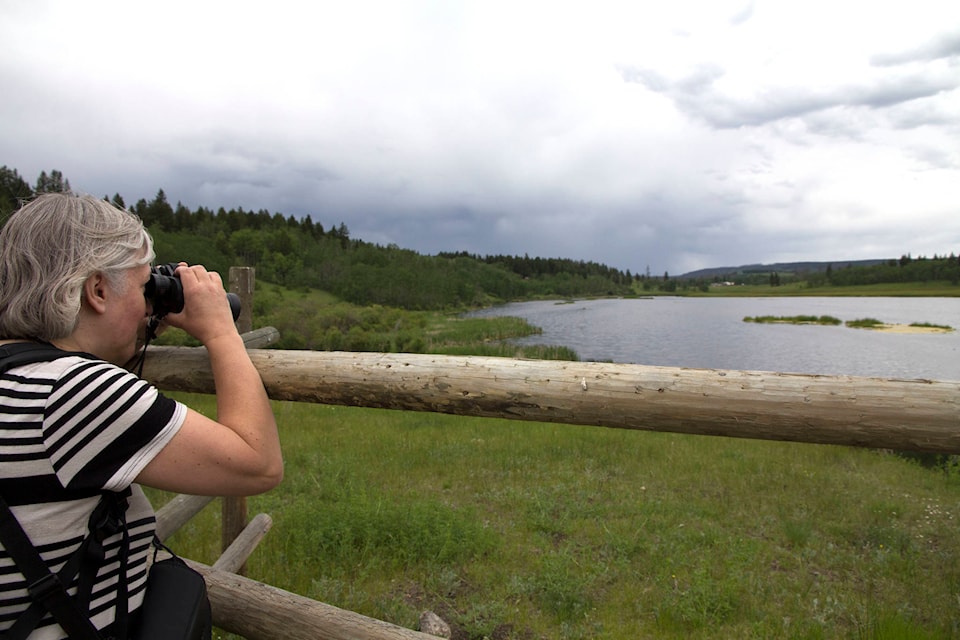The 108 Mile Ranch Greenbelt Commission plans to add gates and more signage to its trails and grasslands to remind dirt bikers and ATV users to stay away.
Motorized vehicles are prohibited on the 1,500-acre greenbelt, a protected mix of forest, grasslands and wetlands that include 108 and Sepa lakes and the Walker Valley, because they can cause significant damage and potentially introduce noxious or other weeds to the natural ecosystem.
“This is the damage they do,” said Al Richmond, Cariboo Regional District director for Lac La Hache-108 Mile Ranch, referring to photographs of deep, muddy tracks cutting through the grasslands. “We’re going to put in more aggressive signage so they know they’re not allowed.”
The local grasslands are rich in diversity, with many natural plants - from wild geraniums, rushes, and lemon weed - as well as birds that congregate in the riparian area around Walker Valley. The greenbelt trails are open to walkers, hikers, cyclists, horse-riders, electric wheelchairs and snowmobilers, although they too are urged to stick to the designated trails to limit damage to the natural state of the area.
READ MORE: 108 Mile Lake stocked with 1,500 trout
Sue Betuzzi, a retired agrologist who often takes school children on tours of the grasslands, said it’s important to protect the grasslands, which are facing increasing threats from a variety of sources.
On a recent visit to a horse pasture in the Walker Valley, Betuzzi pointed to the small trail wending through tall plants to the Ducks Unlimited ponds.
“We have this one little trail here and people are pretty much using it,” she said. “What can happen if someone starts to make a new trail is that they leave a track and pretty soon you have a muddy strip where it used to be grass. Sometimes weeds will get stuck on the tires of motorized vehicles and they can spread.
“Knapweed is a big concern. It’s a really, really strong plant that produces lot of seeds once it gets started. In the grasslands, it takes over the nutrients and water that the plants need to make it.”
When the ground gets ripped up by motorized vehicles, it can tear away the lichen layer that protects the native plants, damage that can take “some of these plant communities 20, 40, 50 years to recover,” she said. It can also introduce other “increaser” weeds, such as brown grass, that also start to take over. “It’s not bad, it’s not a noxious weed but would show up on a site with more disturbance,” Betuzzi said.
According to a 2009 Grasslands Assessment report by biologist Iverson & MacKenzie Biological Consulting Ltd., 12 of the 20 mapped ecosystems in the 108 Mile greenbelt are listed as endangered (red-listed) or special concern (blue-listed) by the Conservation Data Centre. All of the grassland and many of the wetland ecosystems mapped in the Walker Valley are found on the CDC red- or blue-lists.
The report also noted five of the Cariboo Chilcotin Coast Invasive Plant Committee priority invasive plant species were also found on greenbelt lands, including burdock, Canada thistle, oxeye daisy, scentless chamomile, and spotted knapweed.
Several key recommendations were included in the report, which included providing new cattle forage, establishing a riparian fence along the west side of the Walker Valley ponds, continuing Invasive Alien Plant eradication efforts, actively managing cattle grazing and conducting ongoing grassland monitoring.
“The grasslands of the Walker Valley are all red- or blue-listed ecosystems. All of these areas should be protected from any activity that will damage or remove soils or cause the decline of native bunchgrasses and other native plants,” the report said.
These activities also includes balancing the use of the grasslands with cattle and horse grazing, Betuzzi said. Although the animals are used to reduce the fire risk, over-grazing can be a concern, especially if the grasses are “chomped down” too low.
“Generally you don’t want to remove all of the grass right down to the level because then those plants don’t have the energy from their leaves to grow a new plant next year. It changes the community after a while and you get less desirable species coming in,” she said.
Another issue is ensuring that walkers and cyclists don’t veer off the beaten path.
Betuzzi said the schoolchildren usually take note when she mentions this.
“The only ones that squirm are the ones that are already going off the trail on their bikes,” she said.
Richmond said aside from adding more signs and gates for ATV and dirt bike users, the commission is also looking at how they should manage e-bikes, which have grown in popularity.
As long as they are pedal-assist, he said, they would likely qualify as bicycles and still be allowed.
kelly.sinoski@100milefreepress.net
Like us on Facebook and follow us on Twitter
